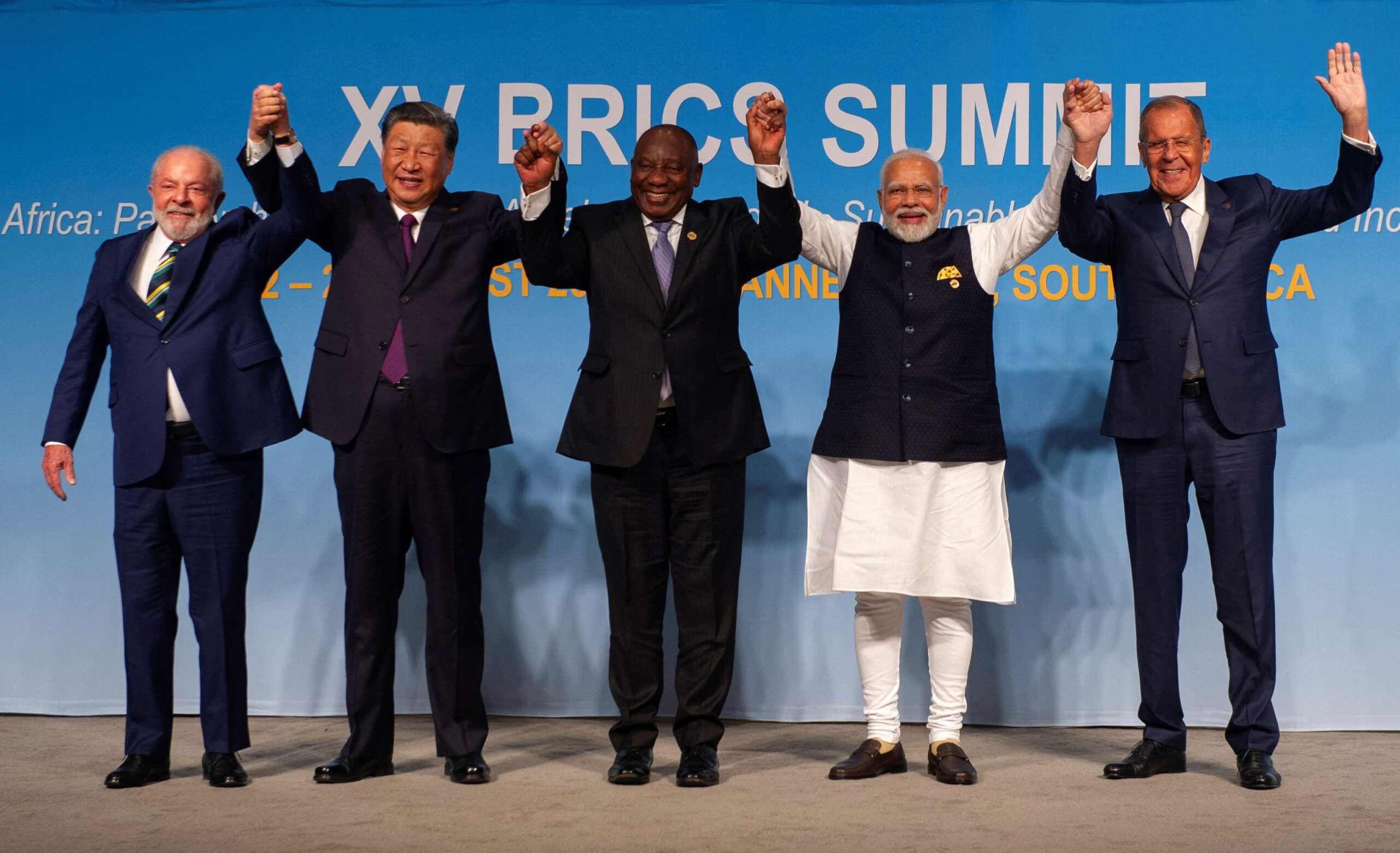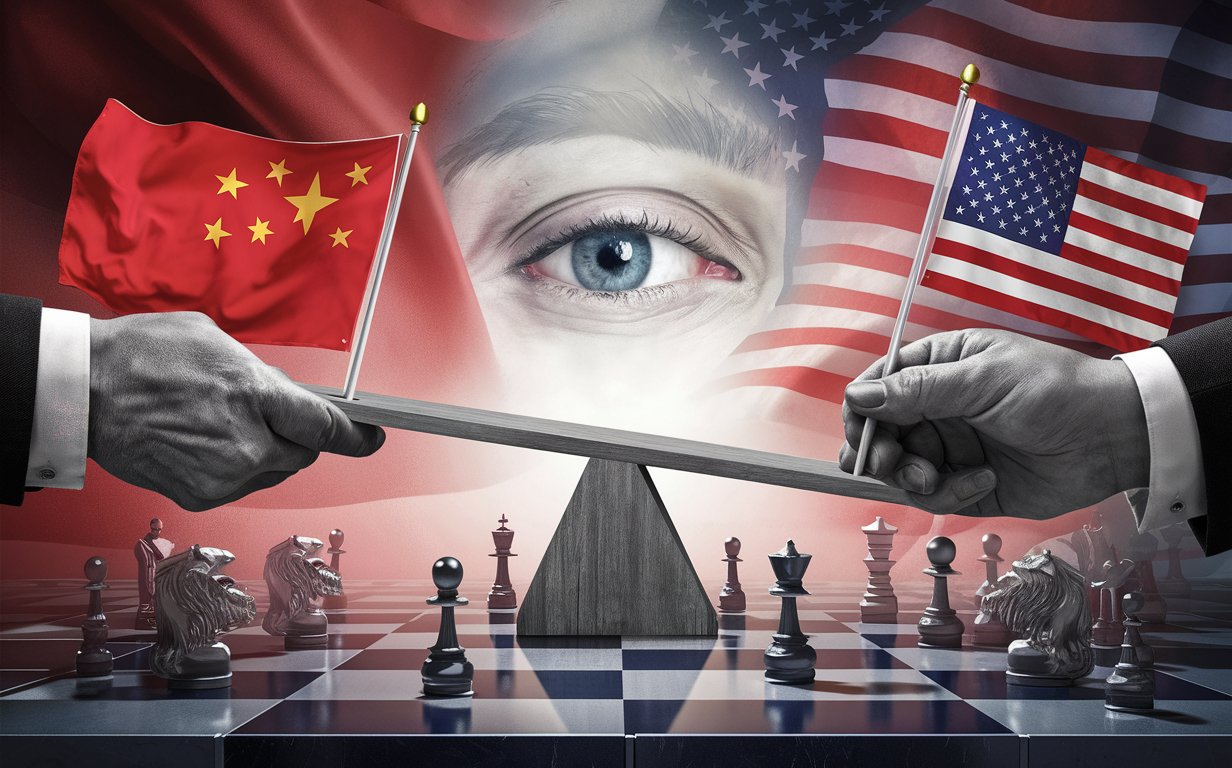Analysis
Climbing the Global Financial Ladder: BRICS Unveil US Dollar’s Hidden Truth

In recent years, the world has witnessed a profound shift in the global economic landscape, with the emergence of the BRICS group (Brazil, Russia, India, China, and South Africa) as major players on the international stage. As these nations continue to gain economic strength and influence, a fundamental aspect of their ascent is the evolving perception of the US dollar’s privileged status. In this article, we delve deep into the true lesson of US dollar privilege and how it resonates with the expanding BRICS nations.
Table of Contents
The US Dollar’s Hegemony
For decades, the United States dollar has reigned supreme as the world’s primary reserve currency. This status has afforded the US numerous benefits, including easier access to capital, lower borrowing costs, and the ability to exert significant influence over global financial systems. It’s a privilege that has often been taken for granted, but it’s one that’s increasingly being scrutinized by the BRICS nations.
The BRICS Challenge
As the BRICS countries have grown both economically and politically, they have become more assertive in challenging the dominance of the US dollar. Their motivation is multifaceted. Firstly, it’s a matter of sovereignty and autonomy. The BRICS nations are eager to reduce their dependence on a currency controlled by a single nation, especially one that has demonstrated its willingness to use the dollar as a tool of foreign policy.
Moreover, the BRICS nations have recognized the inherent risks in the current international monetary system, which is heavily reliant on the US dollar. Economic crises and policy decisions in the United States can have far-reaching consequences across the globe. By diversifying away from the dollar, these nations aim to shield themselves from such vulnerabilities.
The Role of Currency Agreements
One way in which the BRICS nations are challenging the dollar’s hegemony is through bilateral and multilateral currency agreements. For instance, China has been actively promoting the international use of the Chinese yuan, also known as the renminbi (RMB). Through currency swap agreements and trade settlements in RMB, China has been able to reduce its reliance on the US dollar in international transactions.
Russia, too, has been pursuing a similar strategy, seeking to denominate a significant portion of its international trade in Russian rubles. These efforts are not just symbolic; they represent concrete steps towards challenging the dollar’s dominance.
The Impact on Global Finance
The gradual shift away from the US dollar by the BRICS nations has significant implications for the global financial system. It could lead to greater currency volatility, as the dollar’s role as a stabilizing force diminishes. Additionally, it may challenge the United States’ ability to finance its deficits easily, potentially leading to higher borrowing costs.
However, it’s essential to note that the BRICS nations aren’t seeking to replace the dollar with their own currencies entirely. Instead, they are advocating for a more balanced and multipolar international monetary system. This approach reflects a nuanced understanding of the challenges and responsibilities that come with a shift of this magnitude.
The Lessons to Be Learned
The true lesson of the US dollar’s privilege won’t be lost on the expanded BRICS group. It’s a lesson in the complexities of global finance, the importance of financial sovereignty, and the need for a more inclusive international monetary framework.
1. Interconnectedness
The BRICS nations have come to appreciate the interconnectedness of the global economy. Actions taken in one corner of the world can have far-reaching consequences. As such, they are advocating for a more balanced and collaborative approach to international finance.
2. Sovereignty
Sovereignty in financial matters is paramount. No nation wants to be beholden to the policies and actions of another when it comes to managing its own economy. The BRICS nations are championing the idea that each country should have greater control over its financial destiny.
3. Adaptability
Adaptability is key in a rapidly changing world. The BRICS countries have shown their ability to adapt to evolving economic conditions, including by diversifying their currency reserves and embracing new forms of international trade.
Conclusion
The true lesson of US dollar privilege is a reminder that the global economic landscape is evolving. The BRICS nations, through their concerted efforts to challenge the dollar’s dominance, are contributing to this evolution. Their actions signal a shift towards a more multipolar and inclusive international monetary system, one that reflects the changing dynamics of the 21st century.
As we move forward, it’s essential to recognize that the BRICS nations are not seeking to undermine the stability of the global financial system but rather striving for a more balanced and equitable framework. Their lessons in interconnectedness, sovereignty, and adaptability are valuable takeaways for all nations navigating the complex world of international finance.
Analysis
China warns US to choose between cooperation or confrontation: Blinken given ultimatum

According to reports, China has warned the United States that it must choose between “cooperation or confrontation” in their relationship. The comments were made by Yang Jiechi, a senior Chinese diplomat, during a virtual meeting with US Secretary of State Antony Blinken. The meeting was the first high-level talks between the two countries since President Joe Biden took office.

The warning comes amid growing tensions between the US and China over a range of issues, including trade, human rights, and Taiwan. The two countries have been engaged in a trade war since 2018, which has seen both sides impose tariffs on each other’s goods. In addition, the US has imposed sanctions on Chinese officials over the treatment of Uighur Muslims in Xinjiang, while China has been accused of cracking down on democracy in Hong Kong.
The meeting between Blinken and Yang was described as “tough” and “frank” by both sides. While the US has said it wants to work with China on issues such as climate change and the pandemic, it has also called on China to respect human rights and stop its aggressive actions in the South China Sea.
Table of Contents
Diplomatic Ultimatum

China has warned the United States sternly, stating that it must choose between cooperation or confrontation. The ultimatum was delivered by China’s top diplomat, Yang Jiechi, during a virtual meeting with US Secretary of State, Antony Blinken.
Blink en’s Response
Blinken responded that the US is not seeking confrontation with China, but rather wants to ensure that the relationship between the two countries is based on “fairness, reciprocity and respect for international rules and norms.” He also emphasised the importance of addressing human rights issues in China, including the treatment of Uyghur Muslims in Xinjiang.
US-China Relations
The relationship between the US and China has been strained in recent years, with both countries engaging in a trade war and accusing each other of human rights abuses. China’s warning to the US comes as tensions continue to rise between the two nations.
It remains to be seen how the US will respond to China’s ultimatum, but the relationship between the two countries will be a key issue in international relations for the foreseeable future.
Areas of Cooperation and Confrontation

China and the United States have a complex relationship, with areas of both cooperation and confrontation. The following are some of the key areas where the two countries have worked together and where they have faced challenges.
Trade and Economic Policies
China and the United States are two of the world’s largest economies, and their trade relationship is critical to the global economy. However, the two countries have had a long-standing trade dispute, with the US accusing China of unfair trade practices, intellectual property theft, and currency manipulation. This has led to the imposition of tariffs on both sides, which has hurt businesses and consumers in both countries.
Military and Security Issues
China’s growing military power and territorial ambitions have raised concerns in the United States and other countries in the region. The US has accused China of militarizing the South China Sea, and has increased its military presence in the region in response. The two countries have also clashed over Taiwan, with the US supporting the island’s independence and China claiming it as part of its territory.
Human Rights and Cybersecurity
The US has raised concerns about China’s human rights record, particularly in relation to Tibet, Xinjiang, and Hong Kong. China has been accused of suppressing dissent, cracking down on religious and ethnic minorities, and violating international human rights standards. The two countries have also clashed over cybersecurity, with the US accusing China of state-sponsored hacking and cyber espionage.
In conclusion, the relationship between China and the United States is complex, with cooperation and confrontation in several key areas. While there are challenges to be addressed, there are also opportunities for the two countries to work together to address global issues such as climate change and economic development.
Implications for International Relations

Allies’ Reactions
China’s warning to the US about the need to choose between “cooperation or confrontation” has implications for international relations, particularly about how US allies will react. The US has traditionally relied on its allies in the Asia-Pacific region to help counterbalance China’s growing influence. However, some of these allies, such as Japan and South Korea, have been hesitant to take a hardline stance against China, preferring instead to maintain good economic relations with their neighbour.
The recent warning from China could further complicate matters for the US and its allies, as it may force them to choose between maintaining good economic relations with China or siding with the US in a potential confrontation. This could lead to a fracturing of the US-led alliance system in the region, which could ultimately benefit China.
Global Strategic Balance
China’s warning also has implications for the global strategic balance. The US has been increasingly concerned about China’s military modernisation and its growing influence in the Asia-Pacific region. The US has responded by increasing its military presence in the region and strengthening its alliances with countries such as Japan and South Korea.
However, China’s warning could be seen as a challenge to the US’s strategic position in the region. If the US were to back down in the face of China’s warning, it could be seen as a sign of weakness, which could embolden China to further assert its influence in the region.
On the other hand, if the US were to take a hardline stance against China, it could risk escalating tensions and potentially even leading to a military confrontation. This would have serious implications for the global strategic balance, particularly given the nuclear capabilities of both countries.
Overall, China’s warning to the US has significant implications for international relations and the global strategic balance. The US and its allies will need to carefully consider their response in order to maintain stability and avoid further escalating tensions in the region.
Analysis
Columbia’s Gaza Encampment: A Flashpoint in US-Israel Relations and a Growing Movement on Campuses

Introduction
The Ivy League campus of Columbia University has become the centre of a heated stand-off between student activists and the administration over a “Gaza encampment” protest, raising questions about the limits of free speech and the role of universities in shaping political discourse. This article will delve into the background of the controversy, its implications for US-Israel relations, and the broader trend of anti-Israel activism on college campuses.
Background
In early April 2024, a group of Columbia students set up a makeshift encampment on the university’s main quad to raise awareness about the humanitarian crisis in the Gaza Strip and to protest Israel’s policies towards the Palestinian population. The encampment, which was inspired by similar actions at universities in the United Kingdom and Europe, featured anti-Israel slogans and posters, as well as tents and other structures to symbolize the living conditions of Palestinians in Gaza.

The university administration, citing safety concerns and the disruption of campus activities, ordered the students to dismantle the encampment and to refrain from further demonstrations. However, the students refused to comply, arguing that their right to free speech and peaceful assembly was being violated. The stand-off quickly escalated, with both sides digging in their heels and the media descending on the campus to cover the unfolding drama.
Implications for US-Israel Relations
The Gaza encampment at Columbia has raised concerns about the potential impact of the protest on US-Israel relations, which have been strained in recent years over issues such as the Israeli settlements in the West Bank, the status of Jerusalem, and the peace process. The US government, which has traditionally been a strong ally of Israel, has been closely watching the situation at Columbia, with some officials expressing concern about the anti-Israel sentiment on US campuses and its potential to influence public opinion and policy.
At the same time, the protest has also sparked a debate about the limits of free speech and the role of universities in shaping political discourse. While the university administration has the right to maintain order and ensure the safety of its students, critics argue that it should also respect the right to dissent and foster an environment where diverse viewpoints can be expressed and debated.
A Growing Movement on Campuses
The Gaza encampment at Columbia is not an isolated incident, but part of a broader trend of anti-Israel activism on US campuses. In recent years, student groups such as Students for Justice in Palestine (SJP) and Jewish Voice for Peace (JVP) have been organizing events, rallies, and campaigns to raise awareness about the Palestinian cause and to pressure universities and governments to take action.
These efforts have been met with a backlash from pro-Israel groups and individuals, who argue that the anti-Israel activism is one-sided, biased, and harmful to the Jewish community. The debate has often been polarizing and emotional, with both sides accusing each other of intolerance, censorship, and discrimination.
The Role of Universities
The role of universities in this debate is complex and multifaceted. On the one hand, universities have a responsibility to uphold the principles of free speech and academic freedom, which are essential to the pursuit of knowledge and the advancement of society. On the other hand, universities also must ensure the safety and well-being of their students, faculty, and staff, and maintain a campus environment that is conducive to learning and research.
In the case of the Gaza encampment at Columbia, the university administration has tried to strike a balance between these competing interests, by allowing the students to express their views, but also by setting limits on the time, place, and manner of the protest. This approach has been criticized by both sides, with some arguing that it is too restrictive, while others contend that it is too permissive.
Conclusion
The Gaza encampment at Columbia is a microcosm of a larger debate about the limits of free speech, the role of universities, and the future of US-Israel relations. While the stand-off at Columbia may be resolved shortly, the underlying issues will continue to be debated and contested in the months and years to come.
As the debate continues, it is important to remember that the issues at stake are complex and multifaceted and that there are no easy answers or quick fixes. However, by engaging in open and respectful dialogue, by listening to different perspectives, and by seeking common ground, we can work towards a more just and peaceful world, where all voices are heard and valued.
Analysis
BHP’s Proposed £31bn Takeover of Anglo American: A Mining Mega-Deal Amidst Copper Demand Surge

Introduction
The mining industry is on the brink of a seismic shift as BHP, the world’s largest mining company, proposes a £31bn takeover of Anglo American, the fourth-largest mining company. This proposed mega-deal, if successful, would bring together two of the industry’s largest companies, creating a mining behemoth with unparalleled global reach and influence. This article will delve into the details of the proposed takeover, the implications for the mining industry, and the potential impact on the global economy.

Background
BHP and Anglo-American have a long history in the mining industry, with both companies tracing their roots back over a century. BHP was founded in 1885 as a small iron and steel company in Australia, while Anglo-American was established in 1917 as a gold mining company in South Africa. Over the years, both companies have expanded their operations and diversified their portfolios, becoming leading players in the global mining industry.
The proposed takeover of Anglo-American by BHP is not the first time the two companies have been linked. In 2015, there were reports of merger talks between the two companies, but the discussions ultimately broke down due to differences over the terms of the deal. However, the current proposal comes at a time when the mining industry is facing significant challenges, including rising costs, increasing regulation, and a shift towards more sustainable and responsible mining practices.
The Proposed Takeover
The proposed takeover of Anglo American by BHP would create a mining giant with a combined market capitalization of over £100bn. The deal would involve BHP acquiring all of Anglo American’s shares, with Anglo American shareholders receiving 2.1 BHP shares for each Anglo American share they own. The proposed deal would be subject to regulatory approval, as well as the approval of both companies’ shareholders.
The proposed takeover is being driven by the surge in demand for copper, which is a key component in many of the technologies that are driving the global economy, such as electric vehicles, renewable energy, and digital infrastructure. Copper is also a key component in many industrial and consumer products, such as construction materials, appliances, and electronics.
The combination of BHP and Anglo-American would create a mining powerhouse with significant copper reserves and production capacity. BHP is already the world’s largest copper producer, while Anglo-American is a significant player in the copper market, with operations in Chile, Peru, and South Africa. The combined company would have a production capacity of over 2 million tonnes of copper per year, making it the world’s largest copper producer.
Implications for the Mining Industry
The proposed takeover of Anglo-American by BHP is likely to have significant implications for the mining industry. The combined company would have a global reach and influence that would be unmatched by any other mining company. The company would have a diversified portfolio of assets, including copper, iron ore, coal, and other minerals, providing it with a stable revenue stream and reducing its exposure to market volatility.
The proposed takeover is also likely to accelerate the trend towards consolidation in the mining industry. The mining industry has been undergoing a period of consolidation in recent years, with companies seeking to gain scale and reduce costs through mergers and acquisitions. The proposed takeover of Anglo American by BHP is the largest deal in the mining industry since the $38bn merger of Glencore and Xstrata in 2013.
The proposed takeover is also likely to have implications for the mining industry’s approach to sustainability and responsible mining practices. Both BHP and Anglo-American have made commitments to reduce their carbon emissions and to adopt more sustainable and responsible mining practices. The combined company would have a greater ability to invest in sustainable and responsible mining practices, as well as to influence the industry’s approach to sustainability.
Potential Impact on the Global Economy
The proposed takeover of Anglo-American by BHP is likely to have significant implications for the global economy. The mining industry is a key contributor to the global economy, providing raw materials for a wide range of industries and products. The proposed takeover is likely to lead to increased investment in the mining industry, which could lead to increased production and lower prices for key commodities such as copper.
The proposed takeover is also likely to have implications for the global trade and investment landscape. The combined company would have a significant presence in key mining markets such as Chile, Peru, and South Africa, as well as in key markets for mining products such as China and the European Union. The company would be well-positioned to take advantage of the growing demand for copper and other key commodities in these markets.
Professional Opinion
The proposed takeover of Anglo-American by BHP is a significant development in the mining industry, and it is likely to have far-reaching implications for the industry and the global economy. The proposed deal is being driven by the surge in demand for copper, which is a key component in many of the technologies that are driving the global economy.
The proposed takeover of Anglo American by BHP is a significant development in the mining industry, and it is likely to have far-reaching implications for the industry and the global economy. The proposed deal is being driven by the surge in demand for copper and the need for mining companies to gain scale and reduce costs through mergers and acquisitions. The proposed takeover is likely to lead to increased investment in the mining industry, lower prices for key commodities, and greater investment in sustainable and responsible mining practices.
The proposed takeover is also being driven by the need for mining companies to gain scale and reduce costs through mergers and acquisitions. The mining industry has been undergoing a period of consolidation in recent years, and the proposed takeover of Anglo American by BHP is the largest deal in the mining industry since the $38bn merger of Glencore and Xstrata in 2013.
The proposed takeover is likely to have significant implications for the mining industry’s approach to sustainability and responsible mining practices. Both BHP and Anglo-American have made commitments to reduce their carbon emissions and to adopt more sustainable and responsible mining practices. The combined company would have a greater ability to invest in sustainable and responsible mining practices, as well as to influence the industry’s approach to sustainability.
Conclusion
In conclusion, the proposed takeover of Anglo American by BHP is a significant development in the mining industry, and it is likely to have far-reaching implications for the industry and the global economy. The proposed deal is being driven by the surge in demand for copper, which is a key component in many of the technologies that are driving the global economy. The proposed takeover is also being driven by the need for mining companies to gain scale and reduce costs through mergers and acquisitions.
The proposed takeover is likely to lead to increased investment in the mining industry, which could lead to increased production and lower prices for key commodities such as copper. The proposed takeover is also likely to have implications for the global trade and investment landscape, with the combined company having a significant presence in key mining markets and key markets for mining products.
The proposed takeover is also likely to have significant implications for the mining industry’s approach to sustainability and responsible mining practices. The combined company would have a greater ability to invest in sustainable and responsible mining practices, as well as to influence the industry’s approach to sustainability.
-

 Featured3 years ago
Featured3 years agoThe Right-Wing Politics in United States & The Capitol Hill Mayhem
-

 Elections 20242 months ago
Elections 20242 months agoAnalyzing Trump’s Super Tuesday Triumph and Nikki Haley’s Strategic Moves
-

 News2 years ago
News2 years agoPrioritizing health & education most effective way to improve socio-economic status: President
-

 China3 years ago
China3 years agoCoronavirus Pandemic and Global Response
-

 Canada3 years ago
Canada3 years agoSocio-Economic Implications of Canadian Border Closure With U.S
-

 Conflict3 years ago
Conflict3 years agoKashmir Lockdown, UNGA & Thereafter
-

 Democracy3 years ago
Democracy3 years agoMissing You! SPSC
-

 Democracy3 years ago
Democracy3 years agoPresident Dr Arif Alvi Confers Civil Awards on Independence Day
























